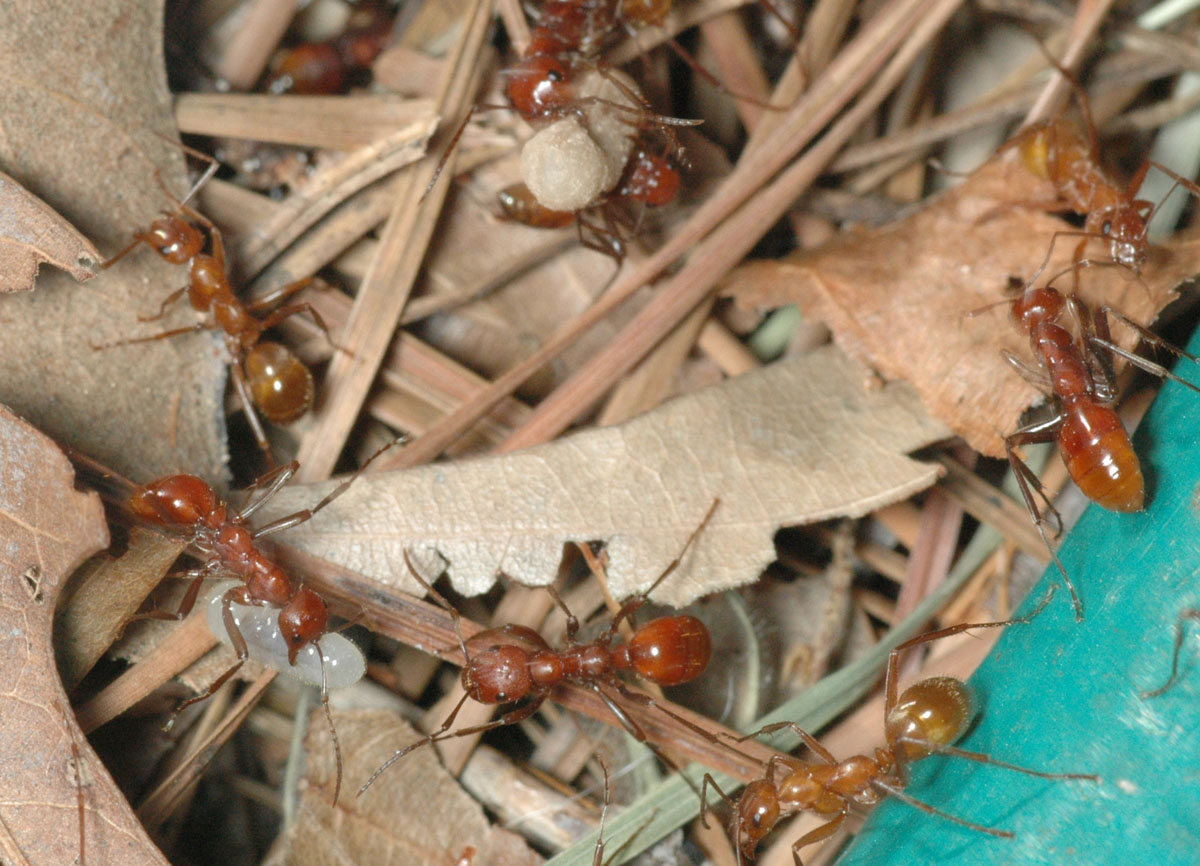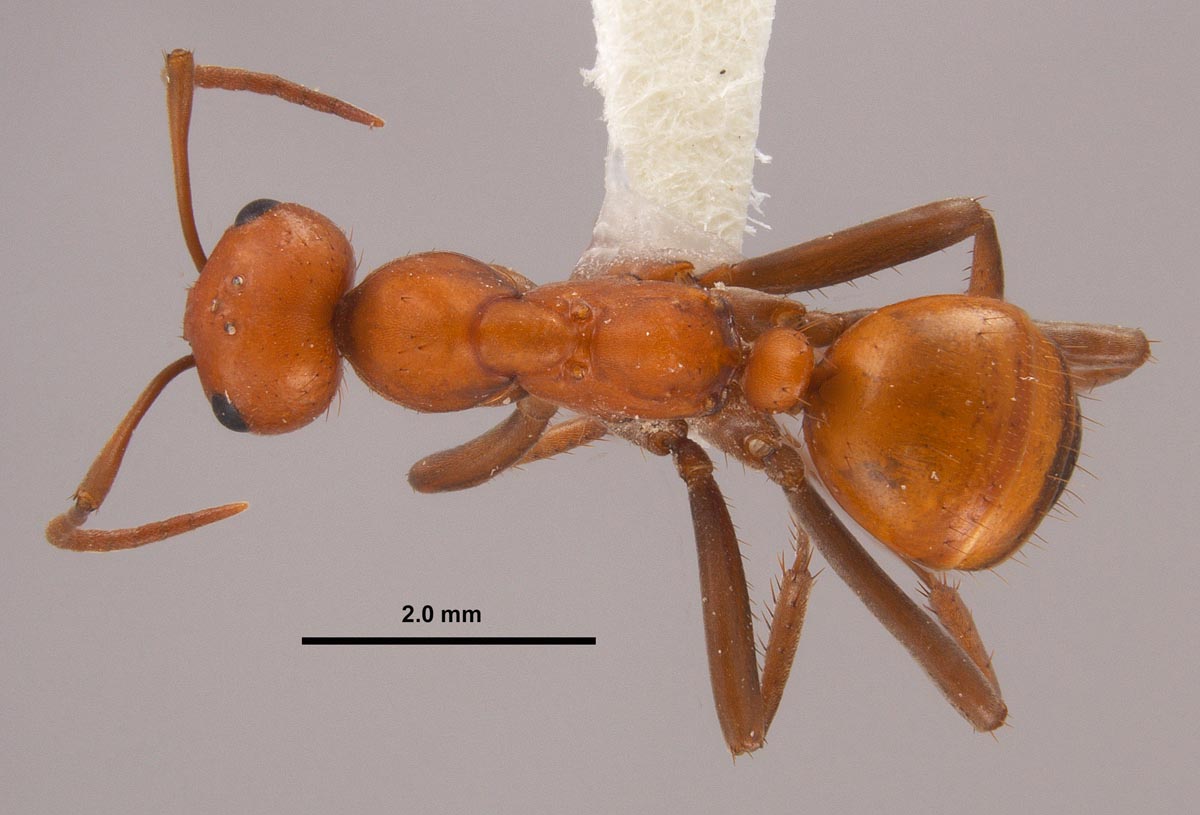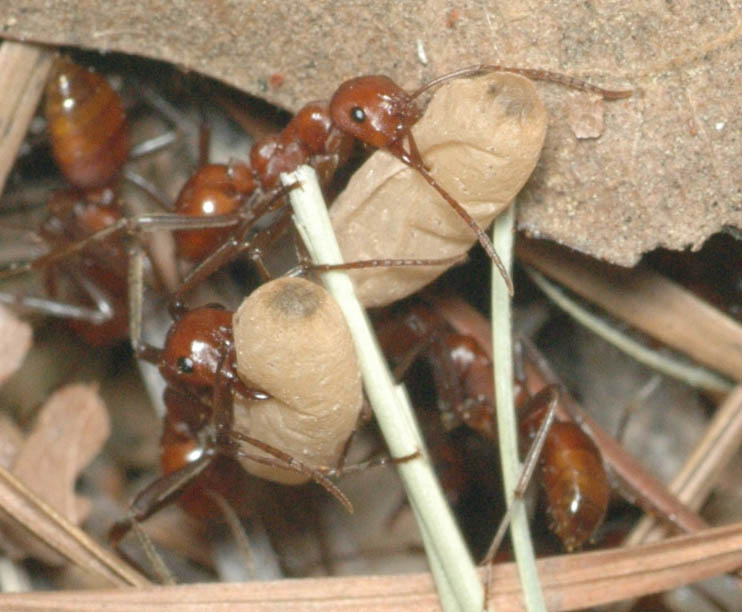Subfamily FORMICINAE by Joe A. MacGown, uploaded 21 July 2009, updated 7 August 2014 |
||
Polyergus longicornis, full face view of a worker (photo by James Lewis and Joe MacGown) |
Polyergus longicornis, profile view of a worker (photo by James Lewis and Joe MacGown) |
Polyergus longicornis, dorsal view of a worker (photo by James Lewis and Joe MacGown) |
Polyergus longicornis, full face view of a queen (photo by James Lewis and Joe MacGown) |
Polyergus longicornis, profile view of a queen (photo by James Lewis and Joe MacGown) |
Polyergus longicornis, dorsal view of a queen (photo by James Lewis and Joe MacGown) |
 |
||
Polyergus longicornis, workers carrying Formica dolosa brood on 8 June 2008 in Sturgis, MS |
Polyergus longicornis, raiding Formica dolosa colony on 8 June 2008 in Sturgis, MS |
Polyergus longicornis, raiding Formica dolosa colony on 8 June 2008 in Sturgis, MS |
Overview Polyergus species are obligatory or true slave-making ants. In nest founding, the female enters a nest of the host species, eventually kills the rightful queen, and uses the host workers to tend her brood. Polyergus colonies conduct slave raids on nests of various species of Formica, and workers of the host are taken and used by the Polyergus colony to feed and rear the brood and excavate the nest. Polyergus workers are incapable of surviving without slaves. In laboratory colonies, a colony without slaves will starve to death even when plentiful food is available. (Hedlund, 2007; King and Trager, 2007) Polyergus longicornis is a matte, reddish colored species known only from the southeastern US where it uses Formica dolosa as its host. Common Name Taxonomic History (from Trager 2013, Bolton 2014) Identification Polyergus longicornis is most similar to P. ruber, but can be distinguished by it greater abundance of setae on the vertex, matte head and mesosoma, and its parastism of F. dolosa instead of F. biophilica. This species can be separated from P. montivagus by its longer antennal scapes, which are more than 1.45 times as long as the interocular distance in P. longicornis, but less than 1.4 times as long in P. montivagus; by its infuscation at the apex of gaster and presence of numerous erect hairs on the vertex corners, both of which are lacking in P. montivagus (1 or 2 erect hairs may be present on each of the vertex corners of P. montivagus). It can be distinguished from P. lucidus by its long antennal scapes, which in P. longicornis are less than 1.4 times as long as the interocular distance in P. lucidus; in P. longicornis, the head and alitrunk are subopaque, whereas, in P. lucidus, the body is shining. Polyergus longicornis differs from P. mexicanus by having much longer scapes, scapes in P. mexicanus are not as long as interocular distance; by not having the antennal scapes terminating in a club (scapes in P. mexicanus enlarged distally forming a club); and by having sparse pubescence on the gaster, whereas, pubescence on gaster of P. breviceps is dense). Biology and Economic Importance Although colonies of the host species F. dolosa, are extremely common in open wooded habitats in the Southeast, especially in upland areas, colonies of P. longicornis are rarely encountered. This is not just a factor of luck in finding colonies either, because for any given colony of P. longicornis to thrive for an extended period of time, it would require many colonies of F. dolosa to support it. Completely eliminating the brood from a single Formica colony could potentially cause the demise of that Formica colony, or, at the very least, brood would not be available for the Polyergus colony until the Formica colony had time to replenish. Therefore, it would seem likely that a single Polyergus colony would need multiple Formica colonies to exist. Indeed, based on the observations of a local resident in Sturgis, Oktibbeha County, MS, Polyergus colonies were seen raiding for many continuous days throughout the summer and usually raiding different Formica colonies each time. Additionally, one observer noted that "their" colony persisted for at least three years, although at one point in time, it relocated the colony location. Alates of this specie have been collected in the summer. This species poses little in the way of economic importance, as is rarely encountered. However, if provoked or handled worker can inflict a somewhat painful bite. Distribution Literature Cited Hill, J. G. and R. L. Brown. 2005. The first record of the genus Polyergus (Hymenoptera: Formicidae) in Mississippi [Abstract]. Journal of the Mississippi Academy of Sciences 50: 120. King, J. R. and J. C. Trager. 2007. Natural history of the slave making ant, Polyergus lucidus, sensu lato in northern Florida and its three Formica pallidefulva group hosts. 14 pp. Journal of Insect Science 7: 42, available online: insectscience.org/7.42 MacGown, J. A. and R. L. Brown. 2006. Survey of Ants (Hymenoptera: Formicidae) of the Tombigbee National Forest in Mississippi. Journal of the Kansas Entomological Society. 79: 325-340. Smith, D. R. 1979. In Catalog of Hymenoptera in America north of Mexico. Smithsonian Institution Press, Washington D. C. Vol. 2, pp. 1323-1427. Smith, M. R. 1947. A Study of Polyergus in the United States, based on the workers (Hymenoptera: Formicidae). The American Midland Naturalist 38: 150-161. Trager, J. C. 2013. Global revision of the dulotic ant genus Polyergus (Hymenoptera: Formicidae, Formicinae). Zootaxa 3722 (4): 501–548. Links |
||










